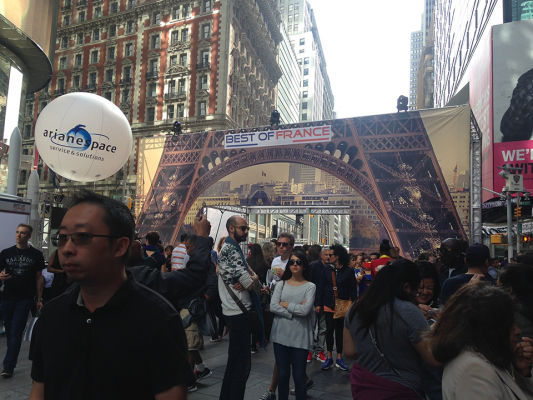Best of France Festival Kicks Off in Times Square
October 1, 2015
Sept. 26 and 27 marked the beginning annual Best of France festival in Times Square. The festivities, formerly called the Taste of France, included live performances, art displays, fashion shows, food and tech startups by French natives. The festival, aimed at increasing tourism and knowledge of the country, was able to reach thousands of spectators from all over the world due to its strategic location off Broadway between 43rd and 38th streets.
Walking through the exhibition, one could see that there was a booth for everyone. At the far end of the spectacle was the Main Stage, where different live musical and dance acts were being routinely performed for those who had entered the festival. However, the musical acts performing were not those one would typically expect at a festival celebrating French culture. Sure, they were all French natives, but their music was very Americanized and catered to their audience in Times Square. DJ Lionel, the most in demand DJ in the country according to the event’s moderator, opened his set with “Uptown Funk” by Mark Ronson and Bruno Mars, before playing French versions of American classics, such as “What a Night” by Frankie Valli and the Four Seasons (very appropriate given the event’s location near the August Wilson Theater where Jersey Boys is performed.).
Apart from DJ Lionel, The event’s musical line up included a Zumba session by Edmee and a special guest appearance by famed French vocalist Daniel Cohen-Biran, better known as his stage pseudonym Dany Brillant. As the night came close to ending, the renowned cancan dancers from the Moulin Rouge were scheduled to perform on the Main Stage as well, bringing the infamous routine to Times Square for the first time in the ensemble’s 126 year history. For those who were unable to stay and watch the performance live, the club had also set up a booth where guests could watch footage of the dancers and take photos in an environment mimicking the inside of the actual house in Paris.
Past the tech booths, there was also the art section, filled with pieces from a multitude of mediums. Centered in front of the cluster was a large sculpture of Lady Liberty’s head and crown, paying homage to the historical relationship between the United States and France. Venturing further into this section, one may have seen various mini exhibitions from established French artists such as Véronique Barrillot. Barrillot was present at the festival and took a few minutes to explain her collection to any attendees interested. The pieces she chose to display had more to them than what meets the eye–literally.
“If you hold your phone up, you can see what is hidden underneath,” Barrillot revealed to me. She went on to explain that she created each piece with two pictures: one that can be seen upon initial glance at the work, and the second of which only comes into focus after further inspection once you take a photo of the painting with a camera.
Barrillot went on to play a game with me, testing my creative eye to see if I could spot both images in each of her pieces: “There is a U.S president hidden underneath this [painting]. Do you know who?”
The president was none other than John F. Kennedy; I had passed her test and gained her approval. Depending on how one looked at Berrillot’s designs, they could view a portrait of John F. Kennedy, a slot machine, a coke can or Albert Einstein to name a few.
Festival attendees could also get their fair share of French delicacies, with options to buy or sample traditional dishes such as French bread with butter and various types of cheese and muffins. Eric Kayser, which was selling their signature baked desserts, had the biggest line of all of the vendors which wrapped around the side of the venue. In addition to their vending booth, Président, a company known for making butter and cheese, was attempting to win a Guiness World Record for largest butter statue ever created. The butter artwork consisted of several different notable monuments from around the world, including the Eiffel Tower.
The festival, instead of trying to dispel all French stereotypes, embraced foreign views of the country and used them as a teaching mechanism to tell attendees about their country’s rich culture. After taking a picture with a sparkly beret and curly mustache in front of the Parisian skyline, festival goers were then able to learn about the history of the country and become culturally immersed in it for the extent of their stay.










